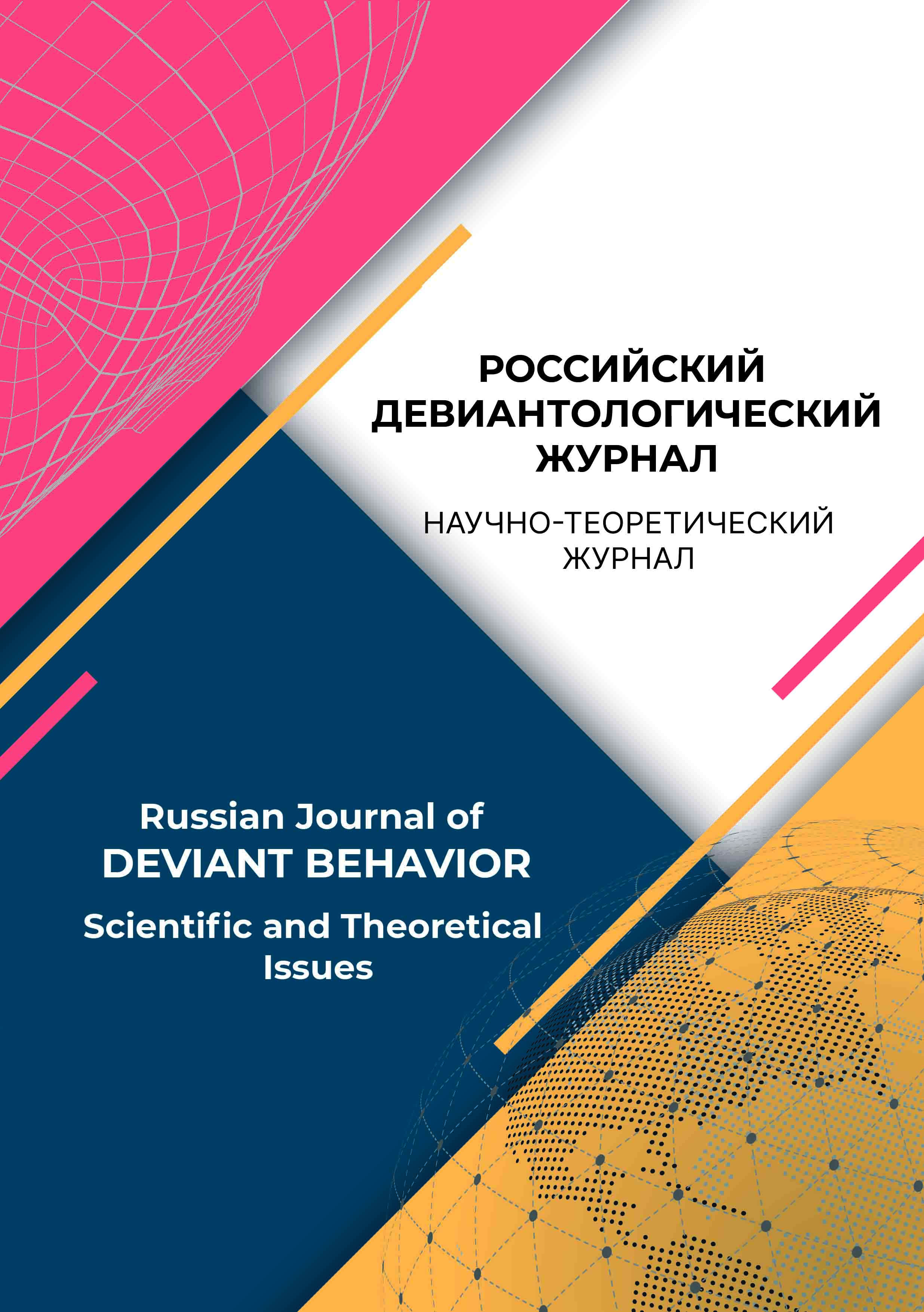Perm military Institute of National Guard Troops
Russian Federation
The author explores a theoretic background and develops an integrative model of self-destruction of personality. The existing views on selfdestruction are local and isolated. The self-destruction has not been researched in the whole commonality of its many factors and sources. A new step in self-destruction research is to study it in terms of integration. The following research turns to the two ways on integration: inductive and deductive. In inductive approach, the author choses a certain set of self-destruction factors (their localization) and raises a question whether they have a common basis. In the deductive approach, on the contrary, the author offers a certain general concept that leads to a set of local factors of self-destruction. Within the framework of the integrative approach, these areas of self-destruction research are considered to be complementary. They form the basis of an integrative model of selfdestruction and develop from the standpoint of the conceptual model of the plural Self. Concerning the deformations of the plural Self, the self-destruction appears as its antipode. There are four domains in the self-destruction of a healthy personality: dissatisfaction with oneself, need to dominate, intolerance, detachment. This model concretizes the heterogenous picture of self-destruction in terms of its domain structure, largely overcomes the isolated notions and generalizes them.
self-destruction, locality, integration, plural self, deformation, domains of self-destruction
1. Antonova, Yu. A., Vesnina. L. E., Voroshilova, M. B., Zlokazov, K. V., Tagil’ceva, Yu. R., Karapetyan, A. A. (2014). Ekstremistskij tekst i destruktivnaya lichnost’. Ekaterinburg: Ural’skij gosudarstvennyj pedagogicheskij universitet.
2. Vyatkin, B. A., Dorfman, L. Ya. (2018). Sistemnaya integraciya individual’nosti cheloveka. Moskow: Institut psihologii RAN.
3. Dorfman, L. Ya. (2004). Ya-koncepciya: differenciaciya i integraciya. V Integral’naya individual’nost’, Ya-koncepciya, lichnost’ (str. 96-123). Moskow: Smysl.
4. Dorfman, L. Ya. (2016). Kauzal’nyj plyuralizm i holizm v koncepcii metaindividual’nogo mira. Psihologiya. Zhurnal Vyss¬hej shkoly ekonomiki, 13(1), 115-153.
5. Dorfman, L. Ya., Zlokazov, K. V. (2016a). Porazhenie i destrukciya i ih issledovanie v zarubezhnoj psihologii. Soobshchenie 1. Vestnik Yuzhno-Ural’skogo gosudarstvennogo universiteta. Seriya «Psihologiya», 9(1), 5-16.
6. Dorfman, L. Ya., Zlokazov, K. V. (2016b). Porazhenie i destrukciya i ih issledovanie v zarubezhnoj psihologii. Soobshchenie 2. Vestnik Vestnik Yuzhno-Ural’skogo gosudarstvennogo universiteta. Seriya «Psihologiya», 9(2), 5-13.
7. Dorfman, L. Ya., Zlokazov, K. V. (2017a). Metaindividual’naya model’ destruktivnosti. Soobshchenie 1. Psihologiya. Zhurnal Vysshej shkoly ekonomiki, 14(1), 105−122. https://doi.org/10.17323/1813-8918.2017.1.105.122
8. Dorfman, L. Ya., Zlokazov K. V. (2017b). Metaindividual’naya model’ destruktivnosti. Soobshchenie 2. Psihologiya. Zhurnal Vysshej shkoly ekonomiki, 14(3), 501−518. https://doi.org/10.17323/1813-8918-2017-3-501-518
9. Dorfman, L. Ya., Kalugin, A. Yu. (2021). Individual’no-intellektual’nye integracii cheloveka. Moskow: Institut psihologii RAN.
10. Zejgarnik, B. V., Holmogorova, A. B., Mazur, E. S. (1989). Samoregulyaciya povedeniya v norme i patologii. Psiholo-gicheskij zhurnal, 10(2), 122-131.
11. Zlokazov, K. V. (2012). Psihologicheskij analiz destruktivnoj lichnosti. V Antropologiya destruktivnosti: kollektivnaya monografiya (str. 163-169). Ekaterinburg: Ural’skij yuridicheskij institut MVD Rossii.
12. Kalinichenko, A. V., Sobol’nikov, V. V., Volkov, G. V. (2014). Narkozavisimost’ kak forma proyavleniya destruktivnoj lichnosti. Medicina i obrazovanie v Sibiri (setevoe izdanie), 2. URL: ngmu.ru/cozo/mos/ article/abautho (data obrashcheniya: 26.10.2015)
13. Kant, I. (2021) (per.). Kritika chistogo razuma. Moskow: AST.
14. Korolenko, C. P., Donskih, T. A. (1990). Sem’ putej k katastrofe: Destruktivnoe povedenie v sovremennom mire. Novosibirsk: Nauka.
15. Leont’ev, A. N. (2005). Deyatel’nost’. Soznanie. Lichnost’ (2-e izd.) Moskow: Smysl: Akademiya.
16. Mendelevich, V. D. (2005). Psihologiya deviantnogo povedeniya. Saint Petersburg: Rech’.
17. Merlin, V. S. (1986). Ocherk integral’nogo issledovaniya individual’nosti. Moskow: Pedagogika.
18. Mitina, L. M. (2004). Psihologiya truda i professional’nogo razvitiya uchitelya. Moskow: Izdatel’skij centr «Akademiya».
19. Petrovskij, V. A. (2013). «Ya» v personologicheskoj perspektive. Moskow: Izdatel’skij dom Nacional’nogo issledovatel’skogo universiteta Vysshej shkoly ekonomiki.
20. Rean, A. A. (2015). Sem’ya, social’nye ustanovki i asocial’noe povedenie detej i podrostkov. Russian Psychological Journal, 12(1), 29-40.
21. Rubinshtejn, S. L. (2003). Bytie i soznanie. Chelovek i mir. Saint Petersburg: Piter.
22. Suslonov, P. V., Zlokazov, K. V. (2013). Metodika provedeniya social’no-psihologicheskih issledovanij po problemam ekstremizma i destruktivnosti v molodezhnoj srede. Rossijskij nauchnyj zhurnal, 5(36), 219- 224.
23. Symanyuk, E. E. (2005). Psihologicheskie osnovaniya professional’nyh destrukcij pedagoga: dis. ... d-ra psihol. nauk. Ekaterinburg.
24. Ushakov, D. V. (2018). Anatomiya psihologicheskogo znaniya. V A. L. Zhuravlev, A. V. Yurevich (red.), Psihologicheskoe znanie: Sovremennoe sostoyanie i perspektivy razvitiya (str. 71-114). Moskow: Institut psihologii RAN.
25. Ushakov. D. V. (2020). Na puti k celostnomu videniyu cheloveka. Psihologiya. Zhurnal Vysshej shkoly ekonomiki, 17(4), 617-629. https://doi.org/10.17323/1813-8918-2020-4-617-629
26. Ashforth, B. E. (1994). Petty tyranny in organizations. Human Relations, 47, 755-778. https://doi.org/https://doi.org/10.1177/001872679404700701
27. Baumeister, R. F. (1990). Suicide as escape from self. Psychological Review, 97(1), 90-113. https://doi.org/10.1037/0033- 295X.97.1.90
28. Baumeister, R. F. (1997). Esteem threat, self-regulatory breakdown, and emotional distress as factors in self-defeating behavior. Review of General Psychology, 1(2), 145−174. https://doi.org/10.1037/1089-2680.1.2.145
29. Baumeister, R. F., & Scher, S. J. (1988). Self-defeating behavior patterns among normal individuals: Review and analysis of common self-destructive tendencies. Psychological Bulletin, 104(1), 3−22. https://doi.org/10.1037/0033- 2909.104.1.3
30. Briones, E., Tabernero. C., & Arenas, A. (2007). Effects of disposition and self-regulation on self-defeating behavior. The Journal of Social Psychology, 147(6), 657-680.
31. Callan, M. J., Kay, A. C., & Dawtry, R. J. (2014). Making sense of misfortune: Deservingness, self-esteem, and patterns of self-defeat. Journal of Personality and Social Psychology, 107(1), 142−162. https://doi.org/10.1037/a0036640
32. American Psychiatric Association, (2013). Diagnostic and Statistical Manual of Mental Disorders, 5th edition: DSM-5.
33. Dorfman, L. Ya., Barashkova, E. A. (2018). Meta-individual account of personality studies. Journal of Psychology and Psychotherapy Research, 5, 40-45. https://doi.org/10.12974/2313- 1047.2018.05.4
34. Ehlers, A., Clark, D. M., Dunmore, E. , Jaycox, L., Meadows, E., & Foa, E. B. (1998). Predicting the response to exposure treatment in PTSD: The role of mental defeat and alienation. Journal of Traumatic Stress, 11 (3), 457-471. https://doi.org/10.1023/A:1024448511504
35. Ehlers, A., Maercker, A., & Boos, A. (2000). Post-traumatic stress disorder following political imprisonment: The role of mental defeat, alienation, and perceived permanent change. Journal of Abnormal Psychology, 109 (1), 45-55. https://doi.org/10.1037/0021-843X.109.1.45
36. Frederick, C. J. (1987). Psychic trauma in victims of crime and terrorism. In G.R. VandenBos, B.K. Bryant (Eds.), Cataclysms, crises, and catastrophes: Psychology in action (pp. 55-108). Washington, DC: American Psychological Association. https://doi.org/10.1037/11106-002
37. Freud, S. (1965). New introductory lectures on psychoanalysis. New York: Norton. (Original work published 1933). ISBN-13: 9780393010640
38. Hawton, K., Rodham K., Evans E., & Weatherall, R. (2002). Deliberate self-harm in adolescents: A self-report survey in schools in England. BMJ: British Medical Journal, 325, 1207-1211. https://doi.org/10.1136/bmj.325.7374.1207
39. Herman, J. L. (1992). Complex PTSD: A syndrome in survivors of prolonged and repeated trauma. Journal of Traumatic Stress, 5 (3), 377-391. https://doi.org/10.1002/jts.2490050305
40. Hyler, S. E., & Rieder, R. O. (1987). Personality Disorder Questionnaire - Revised. New York: New York State Psychiatric Institute.
41. Knauss, W. (1999). The creativity of destructive fantasies. Group Analysis, 32 (3), 397-411. https://doi.org/https://doi.org/10.1177/05333169922076914
42. Lundh, L., Karim, J., & Quilish, E. (2007). Deliberate self-harm in 15-year-old adolescents: A pilot study with a modified version of the deliberate self-harm inventory. Scandinavian Journal of Psychology, 48 (1), 33-41. https://doi. org/10.1111/j.1467-9450.2006.00567.x
43. Kelly, T., Richardson, G., Hunter, R., & Knapp, M. (2002). Attention and executive function deficits inadolescent sex offenders. Child Neuropsychology, 8 (2), 138-143. https://doi.org/10.1076/chin.8.2.138.8722
44. Krasikova, D. V., Green, S. G., & LeBreton, J. M. (2013). Destructive leadership: A theoretical review, integration, and future research agenda. Journal of Management, 39 (5), 1308-1338. https://doi.org/10.1177/0149206312471388
45. Martindale, C. (1980). Subselves: the internal representation of situational and personal dispositions. In L. Wheeler (ed.), Review of personality and social psychology (Vol. 1., pp. 193-218). Beverly Hills: Sage Publications.
46. Miller, J. D., Campbell, W. K., Young, D. L., Lakey, C. E., Reidy, D. E., Zeichner, A., & Goodie, A. S. (2009). Examining the relations among narcissism, impulsivity, and self-defeating behaviors. Journal of Personality, 77 (3), 761-794. https://doi.org/10.1111/j.1467-6494.2009.00564.x
47. Minocha, S., Stonehouse, G., & Reynolds, M. (2014). Bollywood on creativity: An interview with the internationally acclaimed film director Shekhar Kapur. Journal of Management Inquiry, 23 (2), 137-147. https://doi.org/https://doi.org/10.1177/1056492613499825
48. Muller, R. T., Sicoli, L. A., & Lemieux, K. E. (2000). Relationship between attachment style and posttraumatic stress symptomatology among adults who report the experience of childhood abuse. Journal of Traumatic Stress, 13 (2), 321-332. https://doi.org/10.1023/A:1007752719557
49. Myers, D. G. (2009). Social psychology (10th Edition). New York: McGraw-Hill Higher Education.
50. Renaud, J. M., & McConnell, A. R. (2007). Wanting to be better but thinking you can’t: Implicit theories of personality moderate the impact of self-discrepancies on self-esteem. Self and Identity, 6 (1), 41-50. https://doi.org/https://doi.org/10.1080/15298860600764597
51. Reed, G. E, & Bullis, R. C. (2009). The impact of destructive leadership on senior military officers and civilian employees. Armed Forces & Society, 36 (1), 5-18. https://doi.org/10.1177/0095327X09334994
52. Schill, T. (1990). A measure of self-defeating personality. Psychological Reports, 66 (3), 1343-1346. https://doi.org/10.2466/ pr0.1990.66.3c.1343
53. Taussig, H. N., & Litrownik, A. J. (1997). Self- and Other-directed destructive behaviors: Assessment and relationship to type of abuse. Child maltreatment, 2 (2), 172-182. https://doi.org/10.1177/ 1077559597002002010
54. Thoroughgood, C. N., Tate, B. W., Sawyer, K. B., & Jacobs, R. (2012). Bad to the bone: Empirically defining and measuring destructive leader behavior. Journal of Leadership & Organizational Studies, 19 (2), 230-255. https://doi. org/10.1177/1548051811436327
55. Twenge, J. M., Catanese, K. R., & Baumeister, R. F. (2002). Social exclusion causes self-defeating behavior. Journal of Personality and Social Psychology, 83 (3), 606-615. https://doi.org/10.1037/0022- 3514.83.3.606
56. Vazire, S., & Funder, D. C. (2006). Impulsivity and the self-defeating behavior of narcissists. Personality and Social Psychology Review, 10 (2), 154-165. https://doi.org/10.1207/s15327957pspr1002_4
57. Wei, M., & Ku, T.-Y. (2007). Testing a conceptual model of working through self-defeating patterns. Journal of Counseling Psychology, 54 (3), 295-305. https://doi.org/10.1037/0022-0167.54.3.295














